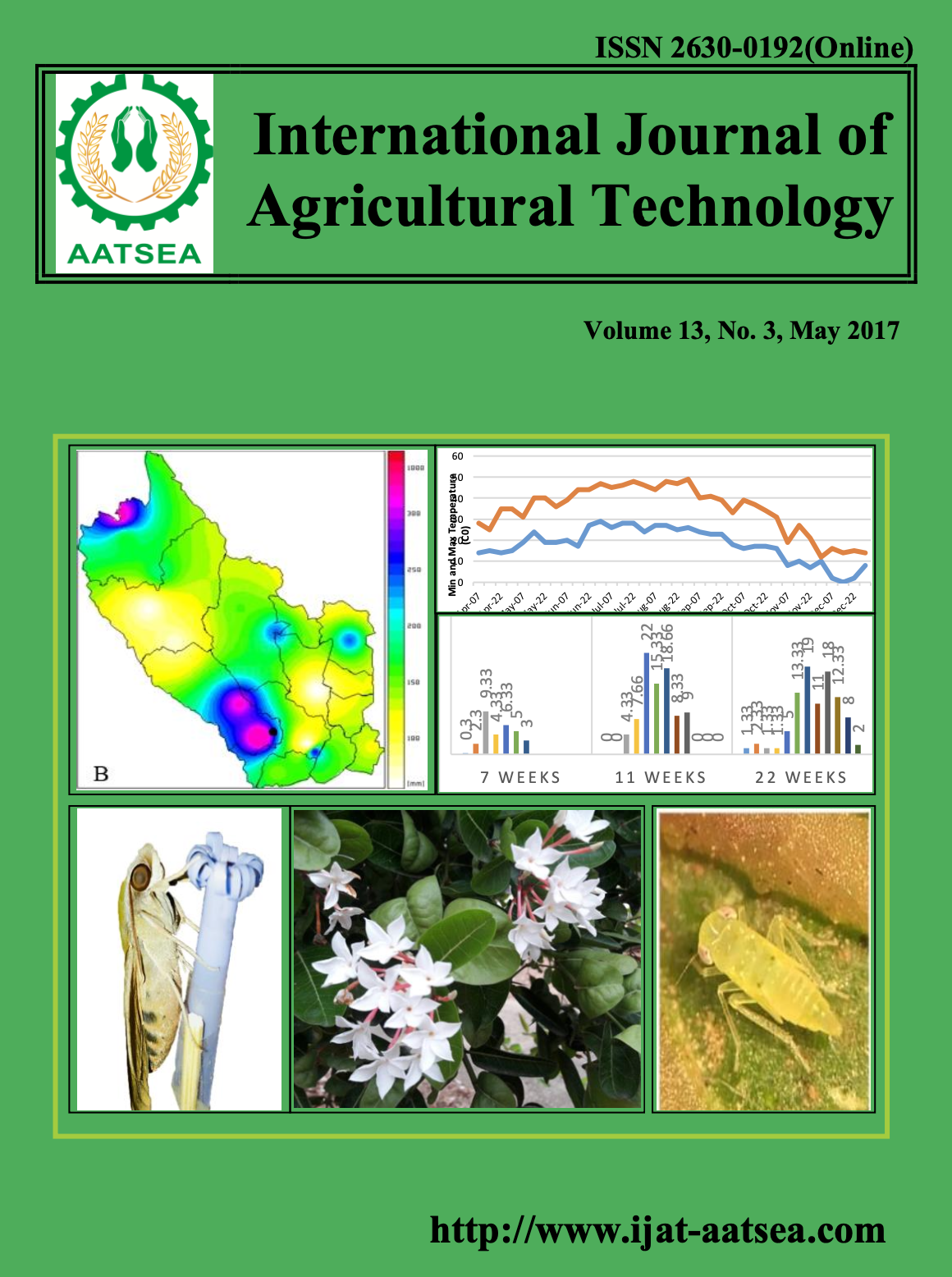Color Attraction of the Crepuscular Hawk Moth (Nephele hespera) (Lepidoptera: Sphingidae)
Main Article Content
Abstract
The crepuscular hawk moth (Nephele hespera) belongs to the family Sphingidae, subfamily Macroglossinae. Hawk moths is known as a pollinator in nature. It is a stenophagous organism which the larva feed only young karunda leaves (Carissa carandas L.). The objectives of this study is to investigate the color and structure of karunda flowers (n=30), crepuscular hawk moths’ proboscis, and the color of artificial flowers attraction and amount of 25% honey solution uptake of the hawk moths. The results showed that karunda’s flowers were white color with a tubular shaped flowers (averaged 19.20±1.16 mm long). The proboscis length of the male and female hawk moth was 46.03±2.33 and 44.03 ± 2.08 mm, respectively. The uptake of honey solution from violet, yellow, pink, white and chartreuse green of artificial flowers was 0.51±0.04, 0.53±0.08, 0.55±0.09, 0.60±0.15 และ0.64±0.12 ml/adult, respectively. The frequency visit of adult hawk moths to various colors of artificial flowers was presented in order from high to low was as follows: chartreuse green, white, yellow, pink and violet.
Article Details

This work is licensed under a Creative Commons Attribution-NonCommercial-NoDerivatives 4.0 International License.
References
Alexandersson R. and Johnson S. D. (2002). Pollinator–mediated selection on flower-tube length in a hawkmoth-pollinated Gladiolus (Iridaceae) Proceedings of the Royal Society of London 269:631-636.
Bauder, J. A. S., Lieskonig, N. R. and Krenn, H. W. (2010). The extremely long-tongued neotropical butterfly Eurybia lycisca (Riodinidae): Proboscis morphology and flower handling. Arthropod Structure and Development 6:122-127.
Borrell B. J., Long, T. and Loose, N. (2005). Evolution of euglossine bees and their nectar flowers. Biotropica 37:664-669.
Darwin, C. (1862). On the various contrivances by which British and foreign orchids are fertilised by insects and on the good effects of intercrossing. John Murray, London.
Gaskett, A. C., Kaczorowski, R. L., Raguso, R. A., Seliger, A. R. and Wigsten, S. K. (2012). Corolla shape vs. size in flower choice by a nocturnal hawkmoth pollinator. Functional Ecology 26:577-587.
Johnson, S. D. and Martins, D. J. (2013). Interactions between hawkmoths and flowering plants in East Africa:polyphagy and evolutionary specialization in an ecological context. Biological Journal of the Linnean Society 110:199-213.
Johnson, S. D., Edwards, T. J., Carbutt, C. and Potgieter, C. (2002). Specialization for hawkmoth and long-proboscid fly pollination in Zaluzianskya section Nycterinia(Scrophulariaceae). Botanical Journal of the Linnean Society 138:17-27.
Johnson, S. D. and Steiner, K. E. (1997). Long-tongued fly pollination and evolution of floral spur length in the Disa draconis complex (Orchidaceae). Evolution 51:45-53.
Kessler, D., Kallenbach, M., Diezel, C., Rothe, E. and Murdock, M. (2015). How scent and nectar influence floral antagonists and mutualists. [Online] Available.https://elifesciences.org/content/4/e07641
Krenn, H. W. (2010). Feeding mechanisms of adult Lepidoptera: structure, function, and evolution of the mouthparts. Annual Review of Entomolog 55:307-327.
Paige, K. N. and Whitham, T. G. (1985). Individual and population shifts in flower color by scarlet gilia: a mechanism for pollinator tracking. Science 227:315-317.
Pauw, A., Stofberg, J. and Waterman, R. J. (2009). Flies and flowers in Darwin’s race. Evolution 63:268 -279.
Taneda, A., Funato, Y., Adach, M. and Negish, H. (2009). Changes in floral volatiles of Neofinetia falcata (Orchidaceae) in a day cycle by HS-SPME-GC-MS. Bioscience. Biotechnology Agrochemistry 84:302.
Riffell, J. A. and Alarcon, R. (2013). Multimodal floral signals and moth foraging decisions. Plos one 8:1-15.
Suetsugu, K., Tanaka, K., Okuyama, Y. and Yukawa, T. (2015). Potential pollinator of Vanda falcata (Orchidaceae): Theretra hawkmoths (Lepidoptera: Sphingidae) are visitors of long spurred orchid. European Journal of Entomology 5:393-397.


